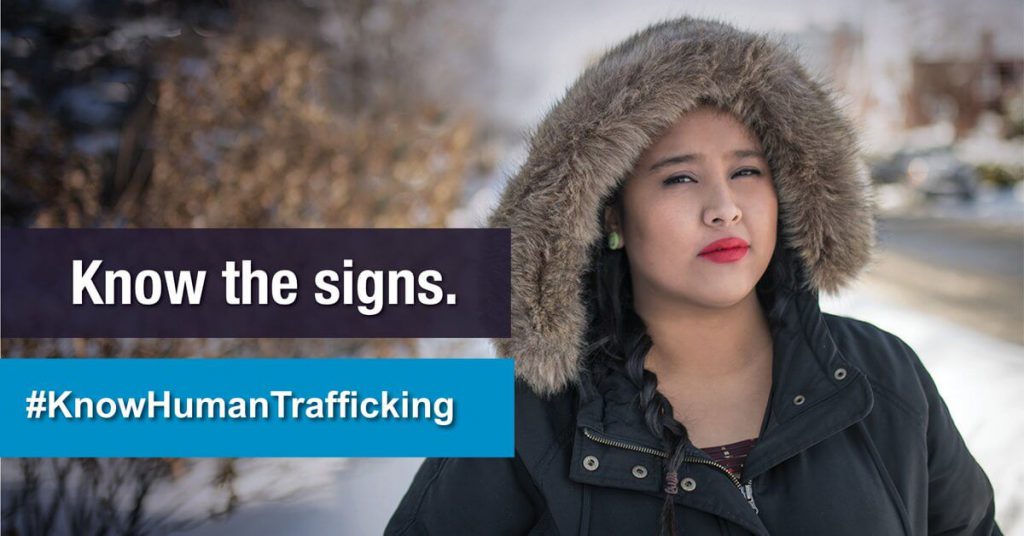Human Trafficking
Human Trafficking Awareness Day – February 22, 2019
Shining a light on human-trafficking in our back yard, stay informed, know the signs. If there is immediate danger or if you suspect a child under 18 is being trafficked, call 911 or your local police service. For information and support, call Ontario’s confidential Human Trafficking Helpline: 1-833-999-9211, TTY 1-888-340-1001
For more information, visit the following website: https://www.mcss.gov.on.ca/en/mcss/programs/humanTrafficking/index.aspx

About Human Trafficking awareness Day:
On February 22, 2019, Ontario recognizes Human Trafficking Awareness Day.
Human Trafficking Awareness Day was established in 2017 through provincial legislation that stemmed from a private member’s bill introduced by the Honourable Laurie Scott.
February 22, 2019 was chosen as Human Trafficking Awareness Day in Ontario because on that day in 2007, the House of Commons of Canada passed a motion condemning the trafficking of women and children across international borders for the purposes of sexual exploitation.
Human Trafficking Awareness Day is an important opportunity to educate community members about what human trafficking is, what the risk factors and warning signs are, and how to get help.
Human Trafficking is far too complex for one person, organization or government to solve. It’s going to take all of us, working together. Increasing public awareness and understanding of human trafficking is the first step.
sited from: https://www.mcss.gov.on.ca/en/mcss/programs/humanTrafficking/index.aspx
Organizations that work to end human trafficking have identified a number of signs that may point to human trafficking:
- The person is not allowed to speak for themselves and their activities are controlled by someone else.
- The person is under 18 and involved in prostitution or sex work.
- The person is unpaid or paid very little to work and seems to be treated poorly (long or unusual hours, not allowed breaks, forced to live in poor conditions, etc.).
- The person is repaying a large debt through labour or sex.
- The person seems fearful, anxious, depressed, submissive, tense, or nervous/paranoid. They may avoid eye contact, seem fearful around police, etc.
- The person shows signs of abuse, such as bruising, cigarette burns, fractures, etc.
- The person has tattooing or branding symbols, particularly names.
- The person doesn’t have their own things or money and doesn’t control their own passport or other documents.
- The person seems malnourished or lacks medical care.
- The person is moved frequently and may not know their surroundings well.
- The person has been reported missing.
Myths about human trafficking:
Myth: Human trafficking is an international crime that involves sneaking someone across a border.
Fact: Human trafficking is sometimes confused with human smuggling, but in reality, it may or may not involve moving someone across a border. In most reported cases of human trafficking in Ontario, the person trafficked is from Canada and is recruited within Canada.
Myth: Human trafficking happens in developing countries, not in places like Ontario.
Fact: Human trafficking occurs throughout the world, including here. According to the RCMP, there have been 269 cases in Ontario since 2005 where human trafficking specific charges were laid. Since human trafficking is an underreported crime, the actual number of cases is likely much larger.
Myth: All sex workers are victims of human trafficking.
Fact: If an adult chooses to engage in consensual, paid sex work on their own terms and is not controlled and exploited by another person, it is not considered human trafficking.
Myth: Sex trafficking can only happen to people who use drugs or have other serious risk factors.
Fact: While some groups have been identified as at-risk, there are also cases in which no known risk factors are present. In those cases, traffickers often target very young people and may build trust during a “grooming” period before exploitation begins.
Myth: If a person isn’t kept locked up or in chains they can always just leave.
Fact: Some people who are trafficked are controlled and monitored constantly and don’t have the opportunity to ask for help. Others may not realize or acknowledge what is happening to them or that it is a crime. In some cases, they may fear their trafficker or law enforcement too much to risk seeking help. They may also be manipulated to believe that the trafficker is the only person who cares about them and that they are best off staying with their trafficker.

